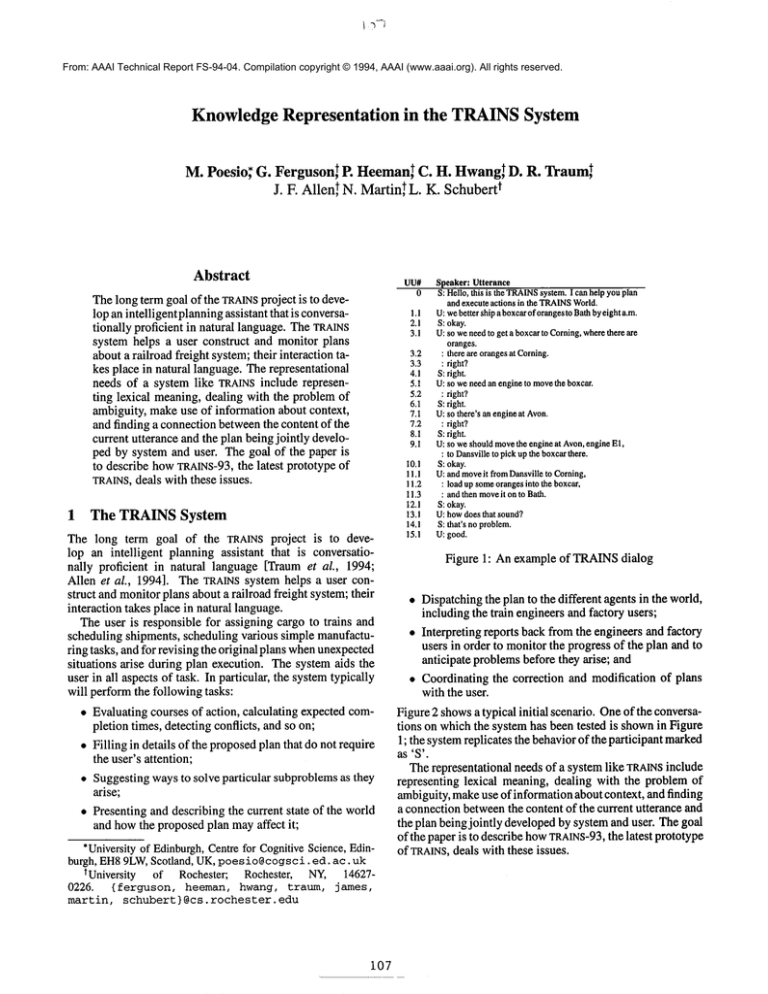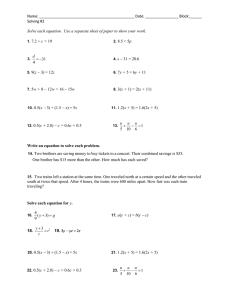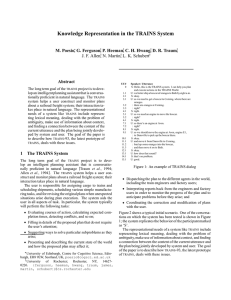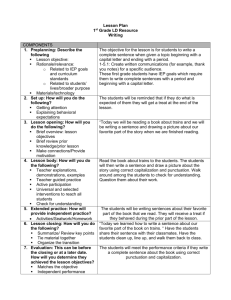
From: AAAI Technical Report FS-94-04. Compilation copyright © 1994, AAAI (www.aaai.org). All rights reserved.
Knowledge Representation in the TRAINSSystem
M. PoesieS’
G. Ferguson~ P. I-Ieeman~ C. H. Hwang~D. R. Traum~
J. F. Allen, t N. Martin, t tL. K. Schubert
Abstract
The long term goal of the TRAINS
project is to develop an intelligentplanningassistant that is conversationally proficient in natural language. The TRAINS
system helps a user construct and monitor plans
abouta railroad freight system;their interaction takes place in natural language. The representational
needs of a system like TRAINS
include representing lexical meaning,dealing with the problemof
ambiguity, makeuse of information about context,
and finding a connectionbetweenthe content of the
current utterance and the plan being jointly developed by system and user. The goal of the paper is
to describe howTRAINS-93,
the latest prototype of
TRAINS, deals with these issues.
1
The TRAINS System
The long term goal of the TRAINS project is to develop an intelligent planning assistant that is conversationally proficient in natural language [Traumet al., 1994;
Allen et al., 1994]. The TRAINS system helps a user construct and monitorplans about a railroad freight system; their
interaction takes place in natural language.
The user is responsible for assigning cargo to trains and
scheduling shipments, scheduling various simple manufacturing tasks, and for revising the original plans whenunexpected
situations arise during plan execution. The system aids the
user in all aspects of task. In particular, the systemtypically
will performthe following tasks:
¯ Evaluating courses of action, calculating expected completion times, detecting conflicts, and so on;
¯ Filling in details of the proposedplan that do not require
the user’s attention;
¯ Suggesting waysto solve particular subproblemsas they
arise;
¯ Presenting and describing the current state of the world
and howthe proposed plan mayaffect it;
*Universityof Edinburgh,Centre for CognitiveScience, Edinburgh, EH89LW,Scotland, UK,poesio@cogsci, ed. ac. uk
t University of Rochester; Rochester, NY, 146270226. {ferguson,heeman, hwang, traum, james,
martin,schubert} @cs.rochester,
edu
107
UU# Speaker:
Utterance
0 S: Hello,thisis theTRAINS
system.
I canhelpyouplan
andexecute
actions
intheTRAINS
World.
1.1 U:webetter
shipaboxcar
oforangesto
Bath
byeighta.m.
2.1 S: okay.
toCorning,
where
thereare
3.1 U:soweneedtogeta boxcar
oranges.
3.2 : thereareoranges
at Corning.
3.3 : right?
4.1 S:right.
5.1 U:soweneedanengine
tomove
theboxcar.
5.2 : right?
6.1 S:right.
7.1 U:sothere’s
anengine
at Avon.
7.2 : right?
8.1 S:right.
move
theengine
at Avon,
engine
El,
9.1 U:soweshould
: toDansville
topickuptheboxcar
there.
10.1 S: okay.
11.1 U:andmove
it fromDansville
to Coming,
11.2 : loadupsome
oranges
intotheboxcar,
ontoBath.
11.3 : andthenmoveit
12.1 S: okay.
13.1 U:how
doesthatsound?
14.1 S: that’snoproblem.
15.1 U:good.
Figure 1: An example of TRAINS
dialog
¯ Dispatchingthe plan to the different agents in the world,
including the train engineersand factory users;
¯ Interpreting reports back from the engineers and factory
users in order to monitor the progress of the plan and to
anticipate problemsbefore they arise; and
¯ Coordinating the correction and modification of plans
with the user.
Figure 2 showsa typical initial scenario. Oneof the conversations on whichthe system has been tested is shownin Figure
1; the systemreplicates the behaviorof the participant marked
as ’S’.
The representational needs of a systemlike TRAINS
include
representing lexical meaning, dealing with the problem of
ambiguity, makeuse of information about context, and finding
a connectionbetweenthe content of the current utterance and
the plan being jointly developedby systemand user. The goal
of the paper is to describe howTRAINS-93,
the latest prototype
of TRAINS,
deals with these issues.
7;:::--q
@
w=
..........................................
......
B
....
or
war
h....
oJFac,o,
Figure 2: Trains WorldSet-up for Dialogue Collection
2.1 Episodic Logic
The task of the modulesconcernedwith the interpretation of
utterances, including the Parser, the Scope and Deindexing
(SAD)module,1 the SpeechAct Interpreter, and the Dialogue
I
Manager(see Figure 3) is to arrive at one or morehypotheses
I NL Output
I
about the intended meaningof an utterance. The language
DeSie°~ixnign:nd
1 [ Isntepeer~eA:t 1 I~ Generator I
used to describe the meaningof the utterance must be rich
enoughto allow distinctions in meaningto be captured.
For example, it won’t do to represent the meaningof 5.1
in Figure 1 as "There is an engine x and we need x to move
the boxcar" because it is possible to use that utterance even
in circumstanceswherethere is no engine, but this paraphrase
wouldbe false under these circumstances. Ideally, the lanl Plan Executorh and Monitor I
TRAINS System
guageused to represent lexical meaningsshould also makeit
simple to combinethe meaningsof lexical items in a single
meaning.
The representation used by the Parser to represent lexical
TRAINS World & Agents I
semantics is called Episodic Logic (EL). EL is a situational logic developed as a knowledgeand semantic representaFigure 3: TRAINSSystem Architecture
tion suitable for general NLU[Hwangand Schubert, 1993a;
Hwangand Schubert, 1993b]. The most distinctive feature
of ELis its natural-language like expressiveness. It allows
2 TheRepresentationFormalismsUsedin
for generalized quantifiers, lambdaabstraction, sentence and
predicate nominalization, sentence and predicate modifiers,
TRAINS-93
intensional predicates (corresponding to wanting, needing,
Roughlyput, there are four kinds of ’knowledge’that the mo- believing, etc.), tense and aspect, surface speech act operators, and explicit situational variables together with operators
dules of TRAINS-93--the1993 implementation of the TRAINS
to specify what’s true at a situation. Eachof the phrasestrucsystem, whose architecture is shownin Figure 3--need to
ture rules in the TRAINS
grammaris paired with a semantic
represent: information about the meaningof an utterance,
rule, and the Parser computesthe initial, underspecified EL
informationabout the current context of interpretation, inforrepresentation of an utterance as it builds a parse tree for the
mationabout the ’world’, and information about the plan. At
the beginning of the TRAINS project, the decision was made utterance.
not to adopt a single representation formalismto be used by
The modules of TRAINS more directly involved with the
interpretation of utterances also have to worry about ambiall modules; the developers of each modulewere left free to
adopt whicheverrepresentation was best suited for their task.
guity. As the parser does not do reference resolution and
As a result, several different representations and their assoscope disambiguation, the representation it producesmust be
ciated reasoning methodsare currently used in the TRAINS underspecified,in the sense that it mustindicate whichaspects
of the utterance’s meaninghave to be resolved in context; as
system. Eachof these will be presented briefly, and its use
well, it must not represent a commitment
to a specific scope
illustrated by meansof an examplefrom the conversation in
of operators. In other words,the ability to represent semantic
Figure 1, sentence 5.1, repeated here for convenience. In
section 3 wereturn to the issue of having multiple formalisms ambiguityimplicitly is required.
in an NLPsystem.
1This module performs scope assignment and reference
5.1 U: So we need an engine to movethe boxcar.
(1)
resolution.
I
I
I08
i . !
The initial representation producedby the Parser is underspecified in that it maycontain unscopedoperators (quantifiers, in particular), indexical expressions(e.g., tense operators) and ambiguouspredicates. For example, adverbial
infinitives are initially translated using the ambiguouspredicate, IN-DISCOURSE-RELATION,
which will be later particularized into FOR-PURPOSE, WITH-RESULT,etc. Situational
variables are introducedinto the representationat a later stage
whentense-aspect operators are processed. Both the Scope
and Deindexing module and the Speech Act Analysis module
operate on the basis of such underspecified representations,
and generate hypotheses about which one amongthe available
interpretations was intended.
The Parser producesfor (1) the underspecified representation shownin (2). It can be thought of as a parse tree whose
leaves have been replaced by the semantics of lexical items.
The labels S._N2+V2,V2__V+N2,
etc. represent the left-hand
side and right-hand side categories occurring in the phrase
structure rule used. The semantic aspect of the rule is formulated as Episodic Logic expressions, represented as Lisp
expressions of the form (<key>< 5. t era> + ), where <key>
indicates the semantic object represented by the expression.
For example,the key : F indicates a functional application of
the first argumentto the rest, the key : r, indicates a lambdaexpression, and the key : 0 indicates an unscopedoperator.
(2)
(1 UT~
(I S-TELL (:F :DECL
(i S_CONJCOORD+S (:I :UTT-IMP 1
(i SO1 :SO-COORD)
(2 S_N2+V2 (:I 1 2) (i WE1
(2 V2_V2 +VINF
( :F ( :F :ADV-A
( :F : IN-DISCOURSE-RELATION
(:F :KA 2)))
(:L :X (:I :X i)))
(i V2_V+PREDNTYPE (:F 1
(I NEED3.3 ( :0 :PRES :NEED-REQUIRE)
(2 PRED_DETAN+NI
(I AN1 :E)
(2 ENGINE1.1:ENGINE))
(2 V2_V+V2BASE (:F 1 2) (i TO1 (:L :X
(2 V2_V+N2 (:P 1
(i MOVE1.1 :MOVE)
(2 N2_DET+NISING (:Q 1
(i THE1 :THE)
(2 BOXCAR1.1
:BOXCAR)
) ) )
(2/RERIOm
NILe))
2.2 Conversation Representation Theory
Conversation Representation Theory (CRT)[Poesio, 1994]
an account of contextual interpretation and ambiguityresolution in conversations. Thelanguageof CRTis a superset of the
language of Episodic Logic; the augmentations are designed
to providebetter tools to describethe contextof interpretation,
especially to indicate whichreferents are available and under
which conditions, and which aspects of a sentence’s meaning
need to be resolved.
In CRT,what takes place after an utterance is producedis
best seen as a process during which alternative hypotheses
about the change in the discourse situation brought about
by that utterance are obtained. A fundamentalaspect of the
theory is that hypothesis generation is a process of context
update; this process is formalized in terms of operations on
2 that represent the discourse situation.
structures called DRSS
Semantically,the maincharacteristic of CRTis that its formulas
2Thisconstruct is borrowedfromDRT[Kampand Reyle, 1993].
109
denote sets of functions from situations to truth values, so
that the language can be used to describe both semantically
’unambiguous’expressions (that denote singleton sets of such
values) and ambiguousexpressions, such as the underspecified
representations obtained by the Parser (that denote sets of
cardinality greater than one).
The underspecifiedrepresentation producedby the Parser is
converted into a CRT expressionthat represents the (surface)
conversational event, or locutionary act, resulting from the
productionof that utterance, and this expressionis addedto the
DRSrepresenting the current discourse situation. The Scope
and Deindexing(SAD)moduleuses the information contained
in the resulting DRSto do inferencesthat resolve contextuallydependentexpressions; this results in one or morehypotheses.
The hypothesis obtained by processing (2) is shownin (3).
As the syntax of CRT is a superset of that of Episodic Logic,
this conversionis mostlystraightforward; weignore the differences in this paper (but see [Poesio, 1994]for a discussion).
(3)
( :SZT-DESCR
:COAl
(:DRS (:CE5950 :CE5951)
( :EV-DESCR:CE5950
(:DRS NIL (:I :HUM :SO-INIT)))
(:I :CE5950 :AT-ABOUT :NOW8)
(:I :CE5950 :SUBSIT :COAl)
( :EV-DESCR:CE5951
( :DRS NIL
( : I : HUM : TELL: SYS
( :SIT-DESCR( :PAR :*S5951" :SIT)
(:DRS (:E5946 :E5945 :X5946)
( :EV-DESCR:E5946
( :DRS NIL
(:I (:SET-OF :HUM :SYS)
( :F :NEED-REQUIRE
( : LAMBDA:Y
(:Q
(:OP :A :X5945
(:I (:PAR :*RES-SIT5945* :SIT)
:* (:I :X5945 :ENGINE
(:I :Y := :X5945)))))))
( :I :E5946 :AT-ABOUT :CE5951)
(:I :E5946 :SUBSIT :S*)
( :EV-DESCR :E5945
( :DRS NIL
(:I (:SET-OF :HUM :SYS)
:MOVE :X5946)))
(:I :E5946 :FOR-PURPOSE :E5945)
(:I :X5946 := :X2887)
( :SIT-DESCR:PLAN1
(:DRS NIL (:I :X5946 :BOXCAR)))))
(:I :CE5951 :AT-ABOUT :NOW9)
(:I :CE5951 :SUBSIT :COAl)
(:I :CE5950 :BEFORE :CE5951)))
This expression states, roughly, that the discourse segment
:COAl(a situation) has been augmentedwith two conversational events, :Cv.950 and :CE951. An expression of
the form ( :DRS ( :A . . . :B) F1 . . . Fn+)
presents a DRS,that in CRTis interpreted as the representation
of a situation type: : A... : 13 are the constituentsof a situation
and each expression Fj represents a fact that has to hold at
that situation.
Of the two conversational events that are part of : COAl,
:CE953_is most relevant; this is an event of the agent :HUM
telling the agent : 5YSthat a situation to be contextuallydetermined, ( : PAR: *$5951" : SIT) is characterized by two
eventualities: : E5946and : E5945. The expression ( : PAR
:*S5951" :SIT) is a parameter. Parameters stand for
’holes’ in the meaningof an utterance that need to be filled
by reasoning, and are used to represent pronouns, definite
descriptions, and so forth. The representation includes the
informationthat the referent : X59 4 6 of the definite description "the boxcar"has beenidentified as being equal to the DRS
constituent : x2 8 8 7 introducedin utterance 3.1.
2.3 EBTL
The EBTLlanguage (EBTL stands for Event Based Temporal Logic) is used as a communicationlanguage betweenthe
Speech Act Interpreter, Dialogue Managerand Plan Reasoner. It is also used by the Dialogue Managerto represent
conversation level information. EBTLis a typed logic based
on that presented in [Allen, 1991] and is implementedusing
the RHETknowledgerepresentation system [Allen and Miller,
1991]. Rhet includes support for type reasoning, temporal
reasoning, hierarchical belief contexts, equality and inequality reasoning. EBTL
adds a muchneededquotation facility (as
someoperators need to treat propositions as terms), lambda
abstraction, existential and definite quantifiers, and discourse
markers. The language is more restricted than those of ELor
CRT:only events and somesimple states can be represented
directly rather than general episodes.
Both hypotheses such as (3) and the underspecified representation in (2) are fed to the SpeechAct Interpreter, which
producesa set of core speech act alternatives and a list of
argumentationacts (whichwill not be discussed). In (4),
speechact definition, expressedin EBTL,is givenfor one of the
possible core speech interpretations, [ ST-CHECK0 02 4 ].
(4)
[:~
(:ROLE [ST-CHECK-0024]
:R-SPEAKER
[HUM]
:ROLE [ST-CHECK-0024]
:R-HEARER [SYS])
:ROLE [ST-CHECK- 0024 ]
:R-TIME [F-TIME [CE5951] ] )
:CONTENT [ST-CHECK- 0024 ]
( :NEED-REQUIRE [SYSHUM]
( :LAMBDA ?O’T-ENGINE
( :DISC-MARKER [X5945] ?O’T-ENGINE ) )
:FOCUS [ST-CHECK-0024] [X5945] )
In general, there can be manyinterpretations for an utterance,
and the mannerin whichthey can provide an interpretation for
the utteranceis specifiedin an alternative list. Thislist relates
the conversationalevent to its interpretations via the predicate
SURF-INTERP.
The manner in which the alternatives can
combineis specified by the operators AND,OR, and EX-OR.
(5)
(SEQUENCE
(SURF-INTERP
[CE5950]
[ST-ACCEPT-0022])
(SURF-INTERP
tCE59Sl]
(AND (OR (EX-0R
[ST-INFORM-0023]
[ ST-CHECK-0024 ]
[ST-YNQ-0025 ] )
[ST-SUGGEST- 0026 ] )
[ST-SUPP-SUO-0027] )))
The Dialogue Manager,reasoning on the basis of the definition of the speech acts, consults the Plan Reasoner; in this
particular case, the final decision is to incorporate a newcomponentin the plan:
(6)
# [(INCORPORATE
( : USE-OBJECT
( :LAMBDA ?o’T-ENGINE
( :DISC-MARKER [X5945] ?o’T-ENGINE ) )
[PLAN-2383 ]
: INCORP-TYPE :ROLE-FILLER
: FOCUS
( :LAMBDA ?o’T-ENGINE
( :DISC-MARKER [X5945]
?o’T-ENGINE
)
: PURPOSE
( :LF-EXISTS
?L’T-MOVE
[E5945]
( :APPLY
( :LAMBDA ?E’T-MOVE
( :AND ( :ROLE ?E’T-MOVE
ii0
:R-AGENT [SYSHUM] )
(:ROLE ?E’T-MOVE
:R-OBJECT [X5946])))
?L*T-M0VE )
(:OCCURS ?L’T-MOVE ))
:CONTEXT
*PLANNER-RETURN3*)#]
2.4 Plans as Arguments
The TRAINS
domainplan reasoner represents plans as connected, directed, acyclic graphs of event and fact nodeslabelled
by events and propositions, respectively. These plan graphs
are given a formal semantics in terms of arguments: they
represent an argumentthat a certain course of action under
certain conditions will achieve certain goals. Since plans are
objects in the ontology,plan description predicates can be defined that imposeconstraints on the plan-as-argument.There
are structural predicates, such as ActionIn, Enables,
Premise, Goal, etc., that are defined in terms of the structure of the plan graph. Thenthere are evaluation predicates.
These include absolute predicates such as Plausible or
Impossible and relative predicates that allow plans to be
compared,for example, according to resource usage or time
constraints. Further details are available in [Ferguson and
Allen, 1994].
As a result of processing utterances 1.1-4.1, the
plan graph corresponding to [ PLAN-2 5 4 5 ] contains two
Move-Carevents: one is moving a car to Corning (where
there are oranges), the other is movinga car from Coming
to Bath (to move the oranges). Although both Move-Car
events in the plan could unify with the purpose formula in
5.1, the first one is preferred as it requires fewer equality
assumptions. In fact though, either choice wouldbe possible
since in either case the Move-Carevent has a role which
can unify with the lambdaexpression describing the engine.
Appropriate assumptions and new parts of the plan graph are
returned to the dialog manageras plan description predicates,
which can then be used to generate helpful suggestions or
request confirmations.
3
Discussion
One of the issues mentionedin the call for papers--the relative advantages and disadvantages of having one or many
formalisms--was repeatedly raised during our work on the
project. Adoptingdifferent formalismsmadeit easier to develop general-purpose componentsthat could also be used in
isolation. In addition, it was not obvious that any existing
formalism wouldhave been appropriate to describe all the
different kinds of information we neededto represent, and we
felt it wasbest to postponeany unification attempts until we
gained a better understandingof the problemswe had to face.
On the other hand, not choosing a single representation
formalismfrom the very beginning involved a risk, namely,
that we wouldend up with a numberof mutually incompatible
representations. In fact, this did not happen.Thereare strong
connections between the formalisms we use, and a numberof
ontological assumptionsare shared, so that most translations
are a straightforward matter.
A numberof factors conspired in keeping the formalisms
weuse relatively close to eachother. First of all, there wasan
unspokenagreement by all to adopt logic-based formalisms.
Secondly, as work progressed, it becamemore and more clear
that a tight interaction betweenthe moduleswas needed; the
typical moduleof TRAINS
has to interact with at least two
other modules,and, in somecrucial cases, this interaction has
to be two-way.A particularly importantcase is the interaction
between the Dialogue Manager and the Plan Reasoner: the
Dialogue Managerhas to be able, on the one hand, to make
decisions on the basis of the current state of the dialog (e.g.,
what speechact is mostplausible during a certain phaseof the
conversation);on the other hand, it also needsto interact with
the Plan Reasoner, and use the information thus obtained to
makedecisions. This effectively forced the Dialogue Manager
and the Plan Reasonerto adopt a unified ontology.
In fact, although at the momentmost modulesdo not access
the information stored by modules’further downthe pipeline’
(e.g., the Parser need not access informationmaintainedby the
Plan Reasoner),it has becomefairly clear that eventually this
will have to change: e.g., the SADmoduleneeds to knowthe
results of SpeechAct interpretation, as these affect discourse
segmentationand therefore the availability of anaphoricreferences. It is likely that a tighter integration amongformalisms
will be reachedin future versions of TRAINS.
This said, it is by no meansclear that in the future all modules of the systemwill be able to access a unified database
of information.In order for that to happen,it is not enoughto
adopt a single representation formalism;it is also necessary
that all modulesadopt the sameontological perspective, and
it’s by no meansclear that that’s possible, or even desirable.
A case in point is the representation of the plan. Fromthe
perspective of the reference resolution module, the plan is
a situation just like any other--an object that contains constituents that can be referred to. This is not, however,the
mostuseful wayfor the Plan Reasonerto look at the plan; the
’argument’perspective is morefruitful.
111
References
[Allen and Miller, 1991] Allen, J. R and Miller, B. W.1991.
The RHETsystem: A sequence of self-guided tutorials.
Technical Report 325, University of Rochester - Computer
Science.
[Allen etal., 1994] Allen, J. E; Schubert, L. K.; Ferguson,
G.; Heeman,P.; Hwang,C. H.; Kato, T.; Light, M.; Martin,
N.; Miller, B.; Poesio, M.; and Traum, D. R. 1994. The
TRAINS
project: A case study in building a conversational
planning agent. In preparation.
[Allen, 1991] Allen, J. F. 1991. Timeand planning. InJ. Allen, R. Pelavin H. Kautzand Tenenberg,J., editors 1991,
Reasoning About Plans. Morgan Kaufmann.
[Ferguson and Allen, 1994] Ferguson, G. and Allen, J. F.
1994, Arguingabout plans: Plan representation and reasoning for mixed-initiative planning. In Proceedingsof the
Second International Conference on AI Planning Systems
(AIPS-94), Chicago, IL. To appear.
[Hwangand Schubert, 1993a] Hwang, C. H. and Schubert,
L. K. 1993a. Episodic logic: A comprehensive, natural representation for language understanding. Mindsand
Machines3:381--419.
[Hwangand Schubert, 1993b] Hwang, C. H. and Schubert,
L. K. 1993b.Episodiclogic: A situational logic for natural
language processing. In Aczel, P.; Israel, D.; Katagiri,
Y.; and Peters, S., editors 1993b,Situation Theoryand its
Applications, v.3. CSLI. 303-338.
[Kampand Reyle, 1993] Kamp,H. andReyle, U. 1993. From
Discourse to Logic. D. Reidel, Dordrecht.
[Poesio, 1994] Poesio, M. 1994. Discourse Interpretation
and the Scopeof Operators. Ph.D. Dissertation, University
of Rochester, Departmentof ComputerScience, Rochester,
NY.
[Traumet al., 1994]Traum,D. R.; Allen, J. F.; Ferguson,G.;
Heeman,P. A.; Hwang,C. H.; Kato, T.; Martin, N.; Poesio,
M.; and Schubert, L. K. 1994. Integrating natural language understanding and plan reasoning in the TRAINS-93
conversation system. In WorkingNotes AAAISpring Symposium on Natural LanguageUnderstandingin Integrated
Systems, Stanford.





